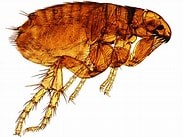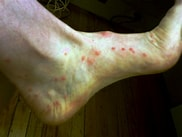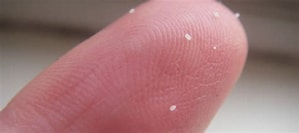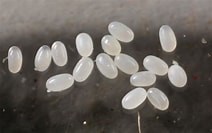All about Fleas – Top Questions and Answers You Should Know…
What are Fleas?

Fleas are tiny bugs. They do not grow much larger than the tip of a pen and range from light brown to almost black in color. They do not have wings, so they get around by jumping from place to place. Their thin, flat bodies and hard shells mean you often need to squeeze them between fingernails or two hard surfaces to kill them. Even then, where there is one, many often follow. Fleas reproduce quickly, especially if you have pets in the house. But even if you do not have pets, your yard can potentially play host to fleas, and you may end up with a bunch of mysterious bites. They are almost impossible to get rid of without a pesticide treatment. The cat flea is the most common flea in North America, although the dog, human and oriental rat fleas can also be found.
What Do Flea and Their Bites Look Like?

Fleas are small, wingless, and approximately 1/20 inch long. Their bodies are shiny and reddish brown in color, covered with microscopic hair and are compressed to allow for east movement through animal hair. While they have no wings, fleas can jump long distances.
Flea bites are distinctive. They look like small, red bumps in clusters of three or four. The bumps remain small, unlike mosquito bites. You might notice a red “halo” around the bite center. The most common places to find these bites are around the legs or ankles. Flea bites are also common around the waist, armpits, breasts, groin, or in the folds of the elbows and knees,
How Do They Reproduce?
Eggs are not attached to the host. Eggs will hatch in the following places: on the ground, in rugs, carpet, bedding, upholstery, and cracks in the floor. Most hatch within two days. For a comparison of actual flea eggs and their respective size, please see the comparison below.


How Did I Get Fleas in the 1st Place?
Flea infestations often come from a pet dog or cat. The pests attach to the animal when it’s outside, and then infest its fur and the places it sleeps indoors. Flea prevention for both the home and yard can be difficult. Without a proactive approach, any pet owner is vulnerable to an infestation.
Fleas depend on a blood meal from a host to survive. On some occasions, fleas may become a problem inside the home when the host they previously fed on is no longer around. Fleas will then focus their feeding activity on other available sources. An example of such a situation is when a mouse inside the home is trapped and removed, the fleas that previously fed on the mouse are then forced to feed on pets or people.
Adult fleas are parasites that draw blood from a host. Larvae feed on organic debris, particularly the feces of adult fleas, which contain undigested blood. Fleas commonly prefer to feed on hairy animals such as: dogs, cats, rabbits, squirrels, rats, mice, other domesticated animals, and wild animals.
What are Some Signs of Fleas?
Many signs can indicate flea activity:
- Pet Scratching – A common indication when pets repeatedly scratch and groom themselves. This is caused by the discomfort of the flea activity as the adult fleas feed on the pet’s blood.
- Bites – People also may experience bites which leave behind itchy bite marks (please confirm with a medical doctor).
- Feces – Flea dirt, the adult flea feces, also can indicate activity. Flea dirt looks like coarse ground black pepper and may be seen in pet beds, carpets, rugs and other areas where the animal host rests. Wearing white socks around the suspected area is an easy way to examine for flea feces on the underside.
- Adult fleas – Fleas are relatively easy to see in their adult stage. Adult fleas are easy to locate, especially if the homeowner and their pets return to the house after a long vacation or other absence during which the adults were not able to take a blood meal. When homeowners return, they are often greeted by fleas jumping around and trying to land on them and their pets.
- Flea Eggs – The flea eggs, larvae and pupae are stages that are much more secretive and much less active. Often, they are found in out-of-the-way places: behind, under or in furniture, pet bedding, inside cracks and grooves in the floors, and in carpets. Eggs initially deposited by the female adult, fall off your pets as they move allowing them to be disbursed throughout their living environment.
How Serious Are Fleas?
Flea bites may leave the host with numerous swollen, itchy marks. They may cause allergic reactions in some people and can transmit several diseases when taking a blood meal from a host or via contaminated fecal pellets. Diseases include plague, flea-borne typhus, Bartonellosis (cat scratch disease), flea tapeworm, and tungiasis.
Furry pets are the most at risk. Fleas can bite people and pets and can be a big nuisance. According to the CDC, the number of illnesses caused by flea bites tripled between 2004 and 2016. The most serious aspect of a flea infestation is often the time and effort it takes to remove. Dealing with the problem requires treating infected animals, cleaning flea-infested areas, and taking preventative measures to keep the fleas from returning.
How Can I Get Rid of Fleas?
Since the immature stages of fleas are very cryptic by nature, the first thing a Connecticut homeowner should do is contact Millette Pest Control for assistance. Simply using over-the-counter products for controlling fleas will likely not resolve the root causes of the infestation.
We will conduct a thorough inspection and locate areas where the immature stages of the flea population are residing. After completing the inspection, the next step is preparing a flea management plan.
Their plan will include:
- Species – identifying the species causing the problem.
- Education – explaining the flea’s life cycle and how their habits, habitat and behavior affects their control plan.
- Host(s) – inspecting for the presence of other animals that are the flea population’s source of food. This may include rodents either inside or outside the home or perhaps a raccoon or feral cat that is living in the crawl space.
- Veterinarian – strongly suggesting the homeowner contact their veterinarian for advice and purchase of flea control products that can be used on pets.
- Pet Bathing – regular bathing and grooming.
- Select Products – explaining the use of growth regulators that will interfere with the flea’s normal development into an adult.
- Vacuum – using a strong vacuum to physically remove flea eggs, larvae, pupae and adults.
- Bedding – frequently washing and drying pet bedding.
- Specific Product Recommendation – treating affected areas by using safe and effective flea control products where immature fleas may be located
- Inspections – scheduling a follow-up visit; often one visit is will not resolve a flea infestation
The most effective practices to keep fleas from getting inside the home is to eliminate outdoor flea habitats and outdoor hosts, plus using area-wide flea control products and veterinarian-approved flea control products on pets.
